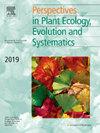Mating patterns of an ambophilous dioecious dominant tree in fragmented Chaco Serrano forests
IF 2.9
3区 环境科学与生态学
Q1 ECOLOGY
Perspectives in Plant Ecology Evolution and Systematics
Pub Date : 2025-02-27
DOI:10.1016/j.ppees.2025.125860
引用次数: 0
Abstract
Lithraea molleoides is a dominant dioecious tree native to the Chaco Serrano Forest, a highly fragmented and threatened ecoregion in central Argentina. The species has ambophily and is able to set seeds via apomixis, traits that may confer resilience to genetic erosion in fragmented forests. We analyzed the genetic diversity of adults and progeny from both continuous and fragmented forests of the Chaco Serrano ecoregion, and conducted paternity assignment and pollen flow analyses. Adult tree populations showed no differences in genetic diversity and structure between continuous and fragmented forests, suggesting they precede the events of habitat loss and fragmentation. In contrast, only the progeny from fragmented forests showed lower genetic diversity and increased inbreeding. Changes in pollinator assemblages in fragmented forests and a higher incidence of apomixis (i.e., only genotypes from female trees reflected in the progeny) may have contributed to reduced genetic diversity in the progeny. Contemporary pollen flow was more restricted in fragmented environments, probably due to changes in pollinator composition and limited wind pollination. While ambophily and apomixis provide reproductive assurance for L. molleoides, our study highlights they cannot prevent the genetic erosion observed in the progeny generated in fragmented forests. These findings have significant implications for conservation strategies aimed at preserving the genetic diversity and viability of L. molleoides populations in the last tracts of Chaco Serrano Forests.
查科-塞拉诺破碎森林中两性雌雄异株优势树的交配模式
Lithraea molleoides是一种主要的雌雄异株树,原产于查科塞拉诺森林,这是阿根廷中部一个高度破碎和受威胁的生态区域。该物种具有两亲性,并且能够通过无融合繁殖而产生种子,这些特征可能赋予它们在破碎森林中抵御遗传侵蚀的能力。对Chaco Serrano生态区连续森林和破碎森林的成虫和子虫的遗传多样性进行了分析,并进行了父系鉴定和花粉流分析。连续林和破碎林的成树种群在遗传多样性和结构上没有差异,表明它们发生在栖息地丧失和破碎化事件之前。相比之下,只有来自破碎森林的后代表现出较低的遗传多样性和增加的近交。破碎森林中传粉者组合的变化和高发生率的无融合(即只有来自雌树的基因型反映在后代中)可能导致了后代遗传多样性的降低。当代花粉流在破碎化环境中更受限制,可能是由于传粉者组成的变化和风传粉的限制。虽然两性性和无融合性提供了L. molleoides的繁殖保证,但我们的研究强调它们不能防止在破碎森林中产生的后代中观察到的遗传侵蚀。这些发现对保护查科塞拉诺森林最后一片带的L. molleoides种群的遗传多样性和生存力具有重要意义。
本文章由计算机程序翻译,如有差异,请以英文原文为准。
求助全文
约1分钟内获得全文
求助全文
来源期刊
CiteScore
6.50
自引率
0.00%
发文量
28
审稿时长
67 days
期刊介绍:
Perspectives in Plant Ecology, Evolution and Systematics (PPEES) publishes outstanding and thought-provoking articles of general interest to an international readership in the fields of plant ecology, evolution and systematics. Of particular interest are longer, in-depth articles that provide a broad understanding of key topics in the field. There are six issues per year.
The following types of article will be considered:
Full length reviews
Essay reviews
Longer research articles
Meta-analyses
Foundational methodological or empirical papers from large consortia or long-term ecological research sites (LTER).

 求助内容:
求助内容: 应助结果提醒方式:
应助结果提醒方式:


